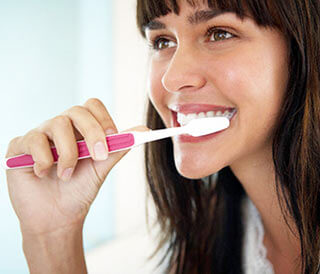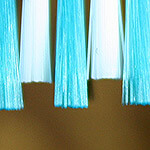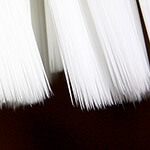
Why brushing your teeth is so important
Brushing your teeth regularly and properly is the number one thing you can do to prevent tooth decay, gum disease, and bad breath because brushing is effective at removing plaque and food particles from your teeth. Plaque is a biofilm which develops on the teeth and is formed by bacteria colonizing and attaching themselves to the surface of a tooth. The anaerobic bacteria that make up plaque consume food particles in the mouth and create volatile sulfur compounds as waste. Volatile sulfur compounds are what make breath smell bad. It is important to get rid of the colonizing bacteria and to also remove their food source in order to maintain a healthy oral flora. The best way to do this is by brushing your teeth.
- Before you brush
- How to brush your teeth
- After you brush
- What toothpaste to use
- What toothbrush to use
- How to tell if your teeth are thoroughly cleaned
- If you experience bleeding while brushing
Before you brush
Before you begin brushing your teeth, you should floss your teeth. Check out our flossing guide to learn how to properly do this. Flossing your teeth once a day is beneficial to oral health and is important because it will remove particles from between your teeth that even the best tooth brushing technique may not be able to remove.
Also before brushing, it is a good idea to brush your tongue. Cleaning your tongue is an important step to remove anaerobic bacteria that cause bad breath. Apply an oxygenating toothpaste (such as TheraBreath Oxygenating Toothpaste) to a soft bristled toothbrush (or tongue brush) and gently brush your tongue with back and forth motions. Be sure to brush as far back on your tongue as possible because that is a common place where bad breath causing bacteria will colonize. After you brush your tongue with the toothpaste, do not spit or rinse the toothpaste out. Leave the toothpaste on your tongue while you brush so it has a longer time to neutralize odorous compounds. Be sure to now rinse your tongue brush.
How to brush your teeth
Believe it or not, there is a technique to brushing your teeth. By following these steps, your teeth will feel cleaner and your chances of getting tooth decay and gum infections like gingivitis will greatly decrease.
Place your toothbrush bristles against your tooth and gum line at a 45 degree angle.
Using small circular motions and tiny back and forth strokes, gently but firmly brush each tooth and just under the gum line.
Start with the teeth at the back of your mouth on one side continuing all the way around to the other side. Cover all tooth surfaces slowly; you should spend a minimum of two minutes brushing your teeth.
To clean the inside surfaces of your front teeth hold your toothbrush vertically and make several small circular motions.
To clean the chewing surfaces, hold your toothbrush with the bristles side down, brush using short back and forth movements on each chewing surface.
Rinse mouth and toothbrush. Read our How to Clean and Store a Toothbrush for great information on keeping your toothbrush clean.
If you are using an electrical toothbrush, simply tilt your tooth brush at a 45 degree angle towards the gum line and move along slowly brushing each tooth's surface, spending about five seconds on each tooth surface.
Tips on brushing your teeth
-
Take your time and spend a minimum of two minutes brushing your teeth.
-
Don't forget to brush all surfaces of your teeth!
-
Do not brush with too much pressure or too vigorously, doing this does not clean your teeth any better and may cause recessed gums and wear down the enamel of your teeth.
-
Long horizontal strokes with your tooth brush are not an effective way to brush your teeth and can also cause irreversible damage to your gums.
After you brush
After you are done brushing your teeth you should now scrape off the particles from your tongue that were dislodged from the tongue brushing you did before brushing your teeth. You scrape your tongue using a tongue scraper. When using a tongue scraper, start from the back to the front. Once again, do this gently but firmly. It should not hurt or cause bleeding. Using a tongue scraper is very important because a lot of bad breath comes from the bacteria that reside on the tongue. Read our Tongue Scraping and Cleaning article for more information on this.
After you clean your tongue, now is a good time to use some mouthwash. Read our article on Using Mouthwash for more information.
Also after brushing, scraping, and using mouthwash, it would be a good time to take some Oral Probiotics to encourage healthy bacteria growth over bad breath odor causing bacteria.
What toothpaste to use
Contrary to popular belief, toothpaste selection is actually the least important factor in effectively brushing your teeth and having good oral health. The most important factor in having fresh breath and good oral health is how well you mechanically remove food particles, plaque, and anaerobic bacteria that cause bad breath from your mouth. Toothpaste aids little in the process of removing any of these from your mouth. By far greater importance is how well you actually brush your teeth.
Nevertheless, there are a plethora of toothpastes out there and some do work better than others. At BreathMD we favor toothpastes that contain no potentially harmful substances such as sodium lauryl sulfate. Great toothpastes we prefer are: Weleda Salt Toothpaste, Earthpaste
, and Biotene Toothpaste
.
What toothbrush to use
Always use a toothbrush with soft bristles. Hard bristles can damage your tooth's enamel causing hypersensitivity. Soft bristles are more effective at removing plaque in hard to reach areas like between your teeth, your back molars and at your gum line. Not all toothbrushes are created equal. At BreathMD we love toothbrushes that have the new fine bristles that are tapered to a very fine point. Most toothbrushes in the market right now have flat tips and have no taper because it easier to manufacture. The tapered tips work much better. ABC Oral Care and Dr. Collins
are two of the few brands that sell these new generation bristles.
Also be sure to change out your toothbrush when the bristles start to wear or every two to three months.
 |
 |
Flat Bristles |
Tapered Bristles |

Do I need an electronic toothbrush?
Short answer, no. You can achieve the same results with a standard toothbrush that you can with an electronic toothbrush, and it is also cheaper. However, it takes more discipline (to ensure proper technique) and time with a standard toothbrush to do the same quality of a brushing as a high quality electronic toothbrush. At BreathMD we have tried various electronic toothbrushes over the years and have found Philips Sonicare
to be our far and away favorite.
How often should you brush your teeth
Ideally you should brush your teeth after every meal and before going to bed. If it is hard for you to brush after every meal because of work, school, or other out of home activities then read our Oral Care on the Go article to help you overcome these challenges.
How to tell if your teeth are thoroughly cleaned
The easiest way to tell if your teeth are properly cleaned after brushing is by feeling around your teeth with your tongue. Your teeth should feel smooth, if they don't feel smooth and you can feel some build up there is still plaque on your teeth. Be sure you have brushed all surfaces of your teeth.
If you want to feel even more confident that your teeth are free of plaque you can buy dental disclosing tablets that will highlight any remaining plaque. If there is still plaque on your teeth the tablets will stain it red, then you will be able to brush it away.
If you experience bleeding while brushing
Your gums should not bleed while brushing your teeth. Bleeding from your gums while brushing may be caused by poor oral hygiene. Make sure you are brushing at least twice a day and flossing once a day. If you are practicing good oral hygiene and there is still bleeding while brushing, this may also occur because your tooth bristles are too stiff (only use soft bristles) or you are brushing too hard or too vigorously. If your gums continue to bleed despite following these measures, see a Dentist right away. Bleeding gums may be a sign of gum disease and should be treated as soon as possible as it can lead to periodontal disease.





Im good at sucking cause im a looser
Smells like bad breath again! Yah im a looser nevermind. oh here's the mint I'd like to suck woohoo
When do you start using an adults toothbrush to brush your teeth with (what age do you start using an adults toothbrush to brush your teeth with
If you use a toothbrush with floss like bristles you should still floss and somebody said it"s better to floss at night because of all the food on your teeth from the day so if you floss at night should you brush afterwards
Dang! I've been doing it wrong all this time. I thought more was better and that I had to use hard bristles and some elbow grease. Oops. Thanks for the good info.
I always thought using a medium or stiff bristles for my toothbrush would clean my teeth better. I tried using soft bristles after reading this article, and I like them much better!